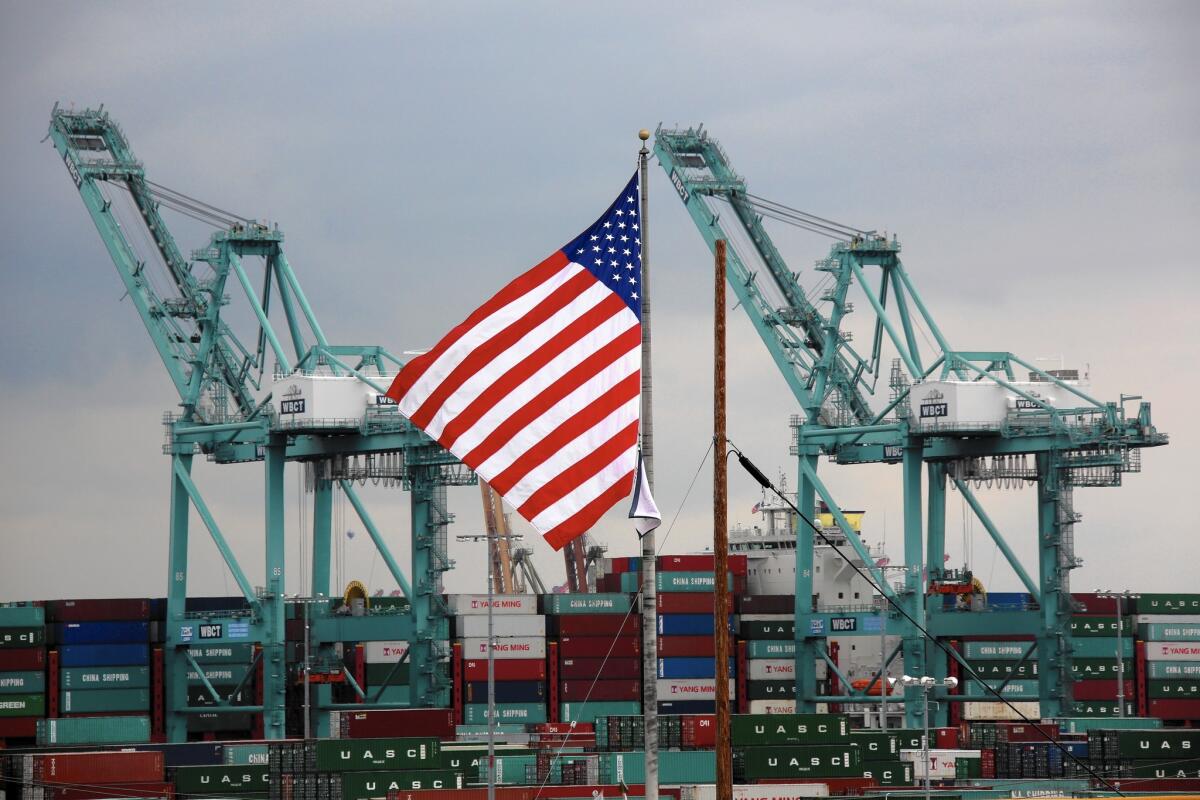How longshoremen command $100K salaries in era of globalization and automation

More than 4,400 ships bring nearly $400 billion worth of goods through the ports of Los Angeles and Long Beach every year, a crucial link in the global supply chain of factories, warehouses, docks, highways and rail lines.
Most blue-collar workers along the chain have seen their wages slashed with the quick rise of global trade. But the longshoremen who move the goods the shortest distance, between ship and shore, have shrewdly protected pay that trumps that of many white-collar managers.
About half of West Coast union longshoremen make more than $100,000 a year — some much more, according to shipping industry data. More than half of foremen and managers earn more than $200,000 each year. A few bosses make more than $300,000. All get free healthcare.
Longshoreman pay dwarfs that of almost all other transit employees, such as trucking, railroad or airline workers. At massive warehouse complexes in the Inland Empire, just an hour’s drive from the ports, goods for the nation’s largest retailers are shuttled around by temporary workers making as little as $10 or $11 an hour, with no benefits or job security.
The unique clout of the International Longshore and Warehouse Union came into sharp relief recently with the partial shutdown of 29 West Coast ports. The crisis passed with a contract deal a week ago, but it will take up to three months to clear the backlog of cargo on the docks and ships stranded offshore. Many businesses and workers won’t recover the money they lost because of port gridlock.
Union spokesman Craig Merrilees said the shipping companies’ pay figures fail to account for the more than 8,000 so-called casual workers — part-timers who don’t receive benefits and often work for years to become registered union members. The data, released by the Pacific Maritime Assn., reflects 90% of the “registered” union members, or more than 12,000 workers.
The association declined a Times request for similar pay data for casual workers and about 1,100 lower-tier union members.
“They don’t want to talk about the other workers,” Merrilees said. “I don’t think it’s responsible.”
How the Pacific longshoremen have weathered forces that have crippled many unions is a tale of foresight, geography and technology.
A deal cut by union leaders half a century ago allowed workers to share in the gains from innovations in efficiency, such as modern shipping containers. Another key move: organizing all West Coast ports in the 1930s under a single contract, which prevents shipping companies from pitting workers at neighboring ports against one another.
More recently, longshoremen benefited from the rise of U.S. trade with other Pacific Rim countries, positioning the ports as a strategic nexus, another key leverage point in wage talks.
“So many labor unions don’t have that power anymore,” said Ruth Milkman, a professor specializing in labor movements at City University of New York. “Here’s a place where globalization has benefited the union, whereas the opposite is true in manufacturing.”
Since 1980, container traffic through West Coast ports has grown more than sixfold, according to the most recent data from the American Assn. of Port Authorities. Pacific ports now handle 52% of U.S. cargo volume, compared with 41% at East Coast ports.
Unlike factories, ports can’t be moved to low-wage countries. The jobs are “impervious to outsourcing,” said John Ahlquist, a political science professor at the University of Wisconsin-Madison who has studied port unions worldwide.
The longshoremen’s union has served as a gatekeeper for new entrants to the industry. There are more than 13,000 registered union longshoremen, clerks and foremen, according to West Coast shipping industry data from 2013.
But the more than 8,000 casual workers compete daily for hours of dock work, hoping to snag leftover shifts after union members get first pick. Many toil for years in a part-time holding pattern, waiting for a new round of hiring.
Patience can pay off. Full-fledged union members are divided into three classes: longshoremen, clerks and foremen/walking bosses.
The majority are longshoremen, about half of whom — 4,900 — made more than $100,000 in 2013, according to shipping company data; 1,400 longshoremen made more than $150,000 in 2013, according to the data.
More than half of the 600 foremen and walking bosses took home more than $200,000. At the top end, 85 of them earned more than $250,000.
Overtime, paid at higher rates, accounts for about a third of all hours worked, according to the shipping industry. Longshoremen also get bonuses for specific skills and night shifts.
Michael Dimon got his start on the docks in 1978, following his father and great-grandfather. He’s proud of the wages he earns, and credits collective bargaining for allowing him to buy a home and save money for his two children to attend college. Dimon never finished high school.
Before 2013, he said, he never made more than $100,000 a year. That year he made $117,000, he said. Last year, he made more, as port traffic at Los Angeles and Long Beach surged to the third-busiest year on record. He declined to say how much.
“I would never pretend to be ashamed of the wages that we negotiate and fight for — absolutely not,” Dimon said. “What it allows me to do is live the American dream. And sadly to say, it’s dying here in America.”
The longshoreman’s dream was forged by a series of strategic decisions that have given the ILWU unparalleled strength.
In the 1930s, West Coast port union leaders succeeded in negotiating a single contract that linked ports from the Pacific Northwest to San Diego.
In 1960, the ILWU cut a deal that paved the way for a revolution in shipping. For centuries, longshoremen had used highly labor-intensive methods when loading and unloading ships — nets, metal hooks and pallets. The union offered to embrace use of containers in exchange for higher pay and benefits, along with richer pensions and buyouts for displaced workers.
The strategy continues to define the union’s approach. In 2002, contract negotiations broke down in part over computer systems intended to replace clerical workers who tracked cargo. The deal led to the elimination of hundreds of clerical jobs, but the union negotiated substantial increases in pension benefits and held on to free healthcare.
In the contract talks resolved last month, one of the main sticking points was over who should maintain and repair the trailers that truckers use to haul goods from the ports. Shipping lines recently outsourced the equipment to third-party firms, threatening the union’s maintenance jobs.
Merrilees, the union spokesman, said the union retained the right to do some inspections and repairs on the trailers. But trade experts said the presence of third-party firms could continue to complicate the issue.
Experts point out that the ILWU’s unique place in the supply chain has allowed it to benefit despite automation. But it’s unclear how long the union can prevent technology from eroding pay and job security.
The union may struggle to maintain high wages in the middle of a low-wage transportation network, said Nelson Lichtenstein, a history professor and director of the Center for the Study of Work, Labor and Democracy at UC Santa Barbara.
“The nail’s sticking up,” he said, “and people have hammers.”
More to Read
Inside the business of entertainment
The Wide Shot brings you news, analysis and insights on everything from streaming wars to production — and what it all means for the future.
You may occasionally receive promotional content from the Los Angeles Times.











